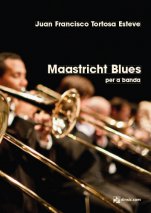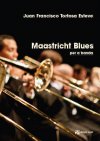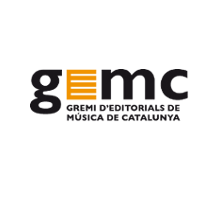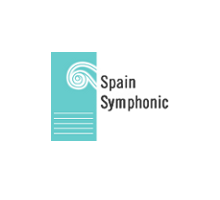Maastricht Blues (parts)

Inside Pages
Author/Composer
Field
Music Schools and Conservatoires Advanced Level
Scores Advanced
Collection
Symphonic Band Materials Nr. 11
Language
Format
Score
Contents
The composition is divided into two movements. I. Het Witte Stadje Thorn (The White Village of Thorn), referring to the town where Henrie Adams was born, and II. Maastricht Blues, the city where Adams studied oboe and musical direction at the prestigious Conservatorium Maastricht music school with Anton Kersjes, Lukas Vis and Pierre Kuijpers. Maastricht is also the city where my valued teacher Jef Penders studied and carried out his professional career, and where he passed away on 15 April 2015. For all this, Maastricht holds a special meaning for me.
The importance of Henrie Adams for the world of symphonic band music in the autonomous community of Valencia is undeniable. No other musical director specialized in conducting bands has ever developed such an important role in the preparation of musicians here, through both his inspiration of Valencian composers and his determined commitment to new works. Henrie’s work represents a turning point in all our professional lives, helping, encouraging and greatly enriching every one of us who has had the fortune and privilege of knowing him and enjoying a friendship with him. For this reason, this composition is a sincere homage to his many years of work here in our land and to his friendship.
The first movement, Het Witte Stadje Thorn, is based on a system of mixolydian modes, which are balanced, lively and festive.
I was once invited by the well-known guitarist and composer Manolo Sanlúcar to his home in Sanlúcar de Barrameda for a week of intense work, living and studying with the great musician twenty-four hours a day. Sanlúcar showed me the secrets behind his methods for composing flamenco music, based on mixolydian modes among other techniques. Manolo Sanlúcar uses this method in a special way as a modal exchange in songs with major tonality to achieve the best possible balance and remove a little of the shine from the commonly-used major mode.
I had never met a musician as generous as Manolo Sanlúcar, nor anyone with his philosophical capacity to understand flamenco and its music so well.
Having said that, in the first movement of Masstricht Blues, this system is used but without a flamenco air, as I have adapted it for our needs in what, I believe, is an interesting and new method of composition within my field of work.
In the second movement, I have used the tonic chord with a seventh , forming a seventh chord, a kind of dominant chord but with ‘colour’ to move the piece into the style of blues. This converts the chords to give a blues flavour to the progressions and a different scale to embellish these tonic chords with seventh.
The mixolydian mode can also be used to prepare melodic compositions over the fifth chord of major tonality, using the tonality mode given by the mixolydian scale.
Instrumental and vocal formations
Mixed ChoirStructure
II. Maastricht Blues
Technical Specifications
Duration
16 min
Measurements
21 x 29,7 cm, vertical
Number of parts
35
Number of Pages of Parts
264
ISMN
979-0-69238-881-4
Editor
DINSIC Publicacions Musicals










